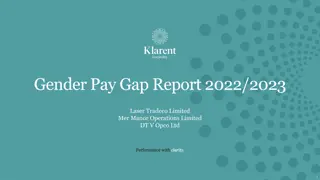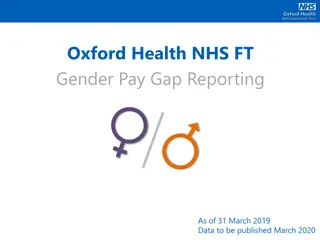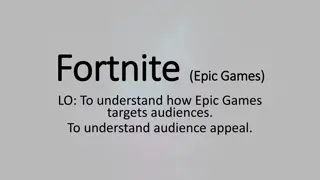The Evolution of Mobile Gaming: From Pay-to-Play to Free-to-Play
The mobile gaming industry has witnessed significant changes in pricing models over the years. With an enormous global audience, mobile games now dominate the gaming market with a shift towards free-to-play models. This evolution has led to innovative monetization strategies such as in-game purchases, virtual items, and ads. Players' impatience and diverse behaviors have prompted developers to adapt economic models to keep players engaged. Explore how the industry has transformed from traditional pay-to-play to the current free-to-play ecosystem.
Download Presentation

Please find below an Image/Link to download the presentation.
The content on the website is provided AS IS for your information and personal use only. It may not be sold, licensed, or shared on other websites without obtaining consent from the author.If you encounter any issues during the download, it is possible that the publisher has removed the file from their server.
You are allowed to download the files provided on this website for personal or commercial use, subject to the condition that they are used lawfully. All files are the property of their respective owners.
The content on the website is provided AS IS for your information and personal use only. It may not be sold, licensed, or shared on other websites without obtaining consent from the author.
E N D
Presentation Transcript
Mobile Games: Pay to (Not) Play Taylor Lundy Joint work with Narun Raman, Hu Fu, Kevin Leyton-Brown
Mobile Gaming is Huge 2.7 billion people worldwide play mobile games People spend nearly 3 times longer on mobile games than Facebook per day https://www.the-numbers.com/market/ https://www.statista.com/statistics/272305/global-revenue-of-the-music-industry/ https://www.statista.com/statistics/324267/us-adults-daily-facebook-minutes/ https://www.globenewswire.com/news-release/2022/02/24/2391544/0/en/Over-Two-thirds-of-U-S-Adults-Increase-Time-Spent-Gaming.html
... and Has Quickly Dominated Gaming 2012-2021 Global Gaming Market $106.3Bn https://newzoo.com/insights/articles/global-games-market-reaches-137-9-billion-in-2018-mobile-games-take-half
Pricing Model Has Changed 80% of mobile games are free to download and start playing!
Something New is Going On Free-to-Play is easily compatible with traditional economic models try-before-you-buy subscription models monetize through ads The player behaviours mobile games monetize often need new economic models virtual items buying lives paying to avoid waiting
Something New is Going On Free-to-Play is easily compatible with traditional economic models try-before-you-buy subscription models monetize through ads The player behaviours mobile games monetize often need new economic models virtual items buying lives paying to avoid waiting
Idle Games: Cow Clicker # of Cows clicked: 1 # of Cows clicked: 2 1 Hr. 2 0 Hrs.
Roadmap How should we model player value for skips? Introduce a model that can explain pricing behaviour in the real-world Validate that model How can we further optimize these prices using tools from mechanism design?
Why On Earth Would Anyone Buy a Skip? Players value accomplishing tasks others can't [Lehdonvirta 2009] Players are impatient 1 hr. 2 These impatience levels are heterogeneous across players ? density impatience
Game Optimization Game designers claim to be optimizing for player happiness Social 1-Player Game A happy player base is good for business [Fields & Cotton 2011] In practice, skip prices can be very high High Churn Rate Top performing games often report 6.5% retention by day 28 Are designers optimizing for revenue instead? https://gameanalytics.com//blog/key-lessons-boost-game-retention/
Skip Prices Affect Values in Two Ways 1. Cheap skips mean more cows will get clicked. We like accomplishing things others haven t so value goes down.
Skip Prices Affect Values in Two Ways 2. Cheap skips mean cows were more likely clicked by skip buyers. # of cows clicked is now a better signal of wealth than dedication Players are trying to signal how dedicated they are to accomplishing tasks; not how much money is in their wallet, so value goes down BOOOOO
Value Must Depend on How Often Players Believe Skips are Purchased Players always know their own type but what do they know about others? Two models of player information: 1. Ex ante Players don t know the distribution over impatience for the specific game they are playing Game designers often have more information about player impatience distribution and actively conceal it from the players ?
Value Must Depend on How Often Players Believe Skips are Purchased Players always know their own type but what do they know about others? Two models of player information: 2. Interim Players know the distribution over impatience for the specific game they are playing In some games, players might have richer knowledge from outside sources (i.e., online communities, wikis, etc.) ? ? 0 1 1 ????
Different Value Functions Require Different Tools We focus on two types of value functions: 1 2 ? ? Value remains steep until it hits the end Value function gets flat quickly
Settings of Interest Player Information Ex Ante Interim Steep Value Function Flat
Settings of Interest Player Information Ex Ante Interim Steep Value Function Flat
Settings of Interest Player Information Ex Ante Interim Steep 1 2 Value Function Flat 3
Settings of Interest Player Information Ex Ante Interim Steep 1 Value Function Flat
1 Notation impatience 1 ? = ? density ?1 ? ? density ?? ?is is always always known designer! designer! known to to the the game game ? = ? ? 0 1 impatience Player ? s marginal value for a skip = 1 ??? ? ? Probability of sale = 1 ? ? ? ? = 1 ?1 ? ? ?
1 What Does Social Utility Look Like? ? ? ? ? = 1 ?1 ? ? ? ? + ?1 ? ? ? ? > 1 ?(?) ? ? ? ? ? ? Buyers Non-Buyers
1 Useful Fact Utility optimal price always above point where ? ? = 1 ? Call this point ????
1 When are Players Happiest with Expensive Skips? ?maxsets ? > 0, such that ?(? ) = ? when ? ? 1 ? ? ?min ? ?min 1 ?1 ? ? ? How much is value still increasing as we reach zero probability of sale How patient is the population of players? Portion of players who would ever purchase a skip at a reasonable price
1 When are Players Happiest with Expensive Skips? Truncated Exponential Distribution ? ? = 1 ? 14
1 What About Revenue? Truncated Exponential Distribution ?max ? = 10 ? ? = 1 ? 14 ? = 0.25 ? = 0.35
1 Evidence from Practice Top Grossing Idle Games Average Revenue Per User Average Revenue Per Paying User Buyer Rate $1.52 USD $29.43 USD 5.1% 1 $0.79 USD $20.32 USD 3.9% 2 $0.68 USD $79.96 USD 1.8% 3 $0.63 USD $27.40 USD 2.3% 4 $0.51 USD $33.99 USD 4.9% 5 75% of Kongregate s revenue comes from just 2.1% of players 1. Don't Call Them Whales: Free-to-Play Spenders & Virtual Value GDC 2021 2. https://blog.kongregate.com/the-rise-and-rise-of-idle-games/
Settings of Interest Player Information Ex Ante Interim Steep 2 Value Function Flat
2 What About the Interim Model? For a while we see the same effect as before Truncated Exponential Distribution
2 What About the Interim Model? When things get too extreme the trend flips Truncated Exponential Distribution
Settings of Interest Player Information Ex Ante Interim Steep Value Function Flat 3
3 Let s Focus on Buyers 1.0 0.8 0.6 0.4 0.2 0.50 1.00 0.25 0.75
3 Let s Focus on Buyers 1.0 0.8 0.6 0.4 0.2 0.75 1.00 0.50
3 How Should we Balance Utility and Revenue? Explicitly model the trade-off by having retention (probability players stay in the game) depend on the utility they achieve. At every round, each player ? draws some outside option ? where ??????? describes their retention probability
3 + MHR How Should we Balance Utility and Revenue? Explicitly model the trade-off by having retention (probability players stay in the game) depend on the utility they achieve. At every round, each player ? draws some outside option ? where ??????? describes their retention probability Once, at the beginning of the game, each player ? draws their type ??? ? ?? 1 ?1 ? = ???? ?? ?=0
3 + MHR Optimal Pricing We could try to optimize the sequence of prices directly, but this doesn t give us a lot of insight Is there something simpler that achieves a constant fraction of the same performance?
3 + MHR Insight from a Designer with Oracle Access to Types Game designer can set different prices for each type Probability Retained Single Round Revenue ? ??(????) ? ? In one round, revenue is exactly price BUT probability they stay in the game decreases
3 + MHR Insight from a Designer with Oracle Access to Types Game designer can set different prices for each type ? ??(????) ? ? ? ????
3 + MHR Insight from a Designer with Oracle Access to Types ??=1 ???(? ?) ???(? ?) ? ??(????) ? ? ?
3 + MHR Insight from a Designer with Oracle Access to Types Charge the minimum of a player s marginal value and ?? ??=1 ???(? ?) ???(? ?) ? ??(????) ? ? 1 ??? ?
3 + MHR Insight from a Designer with Oracle Access to Types Charge the minimum of a player s marginal value and ?? ? ??(????) ??=1 ???(? ?) ???(? ?) ? ? 1 ??? ?
3 + MHR A Good, Simple Pricing Scheme: MT Pricing MT pricing achieves a 1/e fraction of the optimal revenue 1. Compute the same ?? 2. Charge the minimum of the Myerson optimal price and ??in each round ? ??=1 ???(? ?) ???(? ?) myer,?? min ??
3 + MHR Simulations One might worry the upper bound is saving you from some theoretical worst case, but the approximation is not good on average We simulate a variety of possible type and retention distributions to understand where the performance gains of MT pricing occur
3 + MHR Performance of Components of MT Pricing Compare two strategies: Charging Myerson in every round Charging static ??in every round 1. 2. ?? Either approach runs into problems when they charge too high of a price
3 + MHR Performance of Components of MT Pricing Compare the two components: Charging Myerson in every round Charging static retention-based upper bound price in every round 1. 2. Either approach runs into problems when they charge too high of a price Unsurprisingly, adaptively picking the smaller price is usually better than the best performing alternative
Future Directions This is only the tip of the iceberg in terms of microtransactions Generalizations of skips (battle-passes) Monetizing other player behavior (lives in Candy Crush) Incorporating real data Explicitly model secondary effects (why are happy player-bases important?) Focus on real-world settings when evaluating performance























